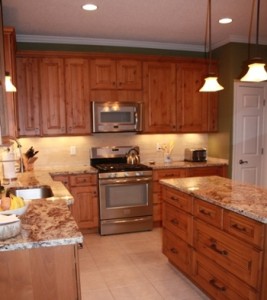 Earlier this year, my husband and I decided to take on our own kitchen remodeling project. Since then, sanity has returned to our kitchen and we have been able to enjoy the fruits of our labor! Part 1 and Part 2 of this series discuss tradeoffs and setbacks… both of which are very real with a project that has so many different elements.
Earlier this year, my husband and I decided to take on our own kitchen remodeling project. Since then, sanity has returned to our kitchen and we have been able to enjoy the fruits of our labor! Part 1 and Part 2 of this series discuss tradeoffs and setbacks… both of which are very real with a project that has so many different elements.
Statistics show that most people will tackle a major kitchen remodel only once (if at all) in their lifetime. As you dream about your own remodel, consider replacing more than just the cabinets and countertops, if possible. A truly functional kitchen consists of more than pretty cabinets and tops. What good are beautiful new cabinets if your old lighting scheme doesn’t do them justice and doesn’t allow you to function in the space? Why bother updating the cabinets while leaving an old floor that you hate? Your kitchen will already be a mess, so why not take advantage of it by adding in some of these other important elements.
- Flooring – rarely will the footprint be the same when changing the cabinets, so you may need to adjust yours to be complimentary.
- Lighting/electrical outlets & switches – I improved my kitchen by adding task lighting, moving a switch and an outlet and adding a dimmer to my main kitchen lights.
- Faucet/disposal – I could have reused the not very old designer faucet, but chose to increase the function by replacing it.
- Appliances – Consider replacing built-in items like microwaves or dishwashers during your remodel. Ranges and refrigerators are a little easier to do after-the-fact.
As discussed in our Hidden Meanings article, your choices do say a lot about you. But, as a designer, what you don’t see often says even more! Functionality is key, and your kitchen designer will help you discover the best options for your situation. I took kitchen upgrades a step further with my remodel and added even more functionality to my cabinets by utilizing the following:
- Roll-outs – what are they? Basically, drawers behind your cabinet doors. You can never have too many drawers, as they add easy access and usability. I love that I have more large drawers than doors now with roll-outs in the pantry.
- Small spaces– I added an aftermarket cookware organizer, a tray pull-out and a spice pull-out to increase the functionality of otherwise useless small spaces.
- Double trash pull-out – These were incorporated to house both the trash and recycling bins keeping them out of plain site.
It is important to maintain a respectable balance between “neutral” and “personality,” especially if you think you might ever have to sell your home. I chose to keep anything glued down or screwed in on the neutral side (cabinets, tile floor and tile backsplash) and brought in personality through the elements that can be replaced (paint color for the walls, lighting pendants over the island, faucet, and granite counter tops -not easy to replace, but do-able).
It’s worth the effort to put serious consideration into how you use your kitchen and how you’d really like all of the elements to function. A good designer will ask a lot of questions about your dream kitchen. Try to imagine the function beyond the pretty new cabinets. Design with no regrets and you will not only survive your kitchen remodel, but you’ll wonder why you didn’t do it sooner!
Getting ready to remodel?

Recent Comments